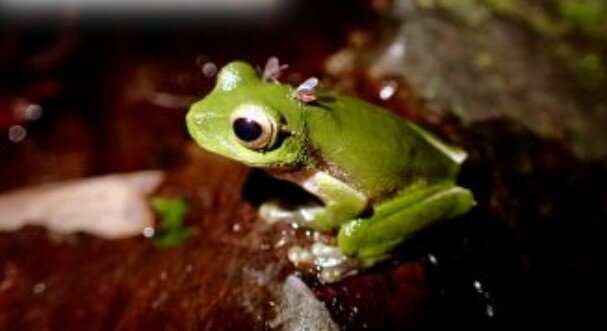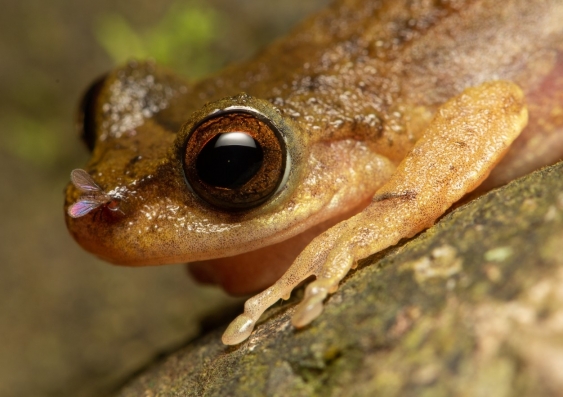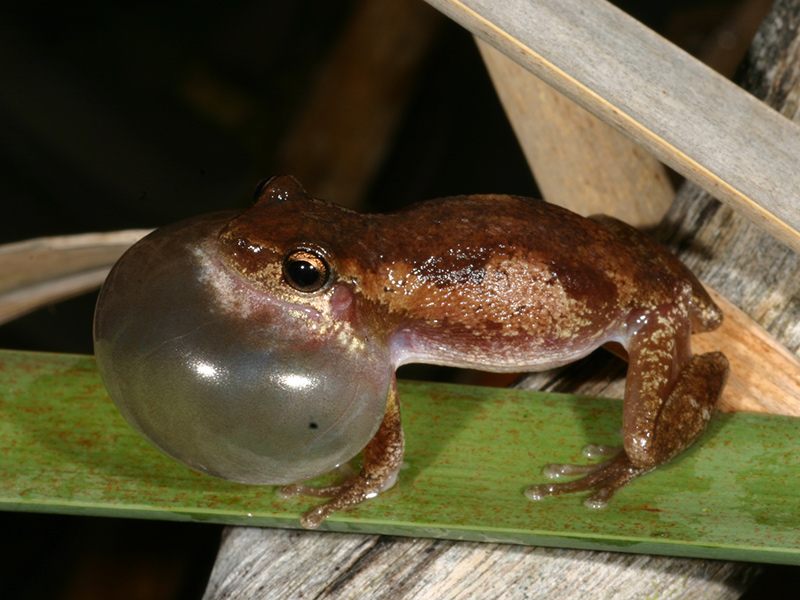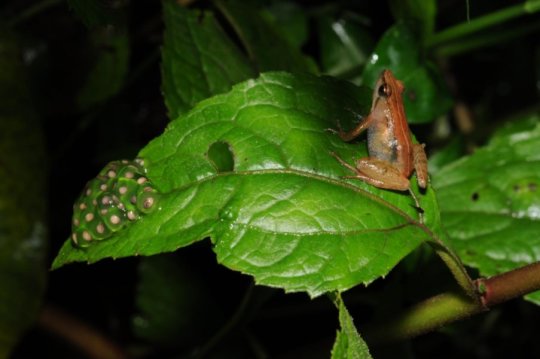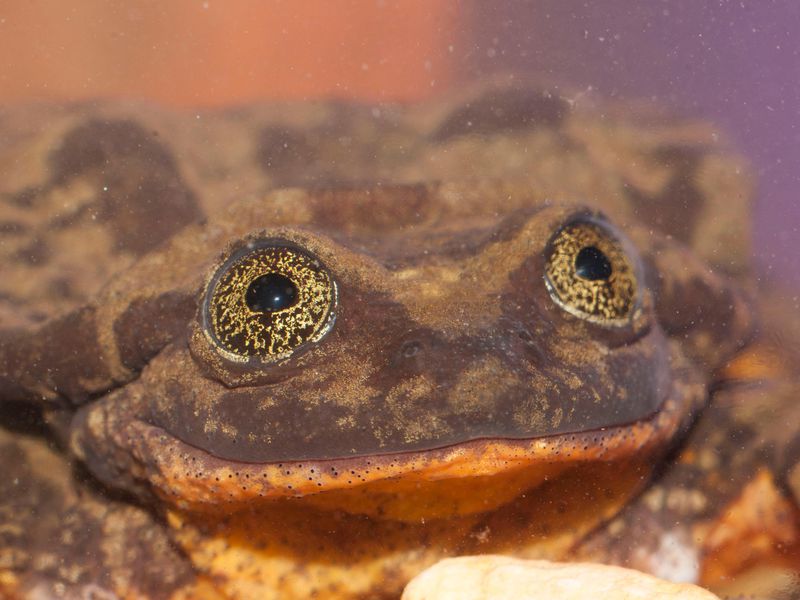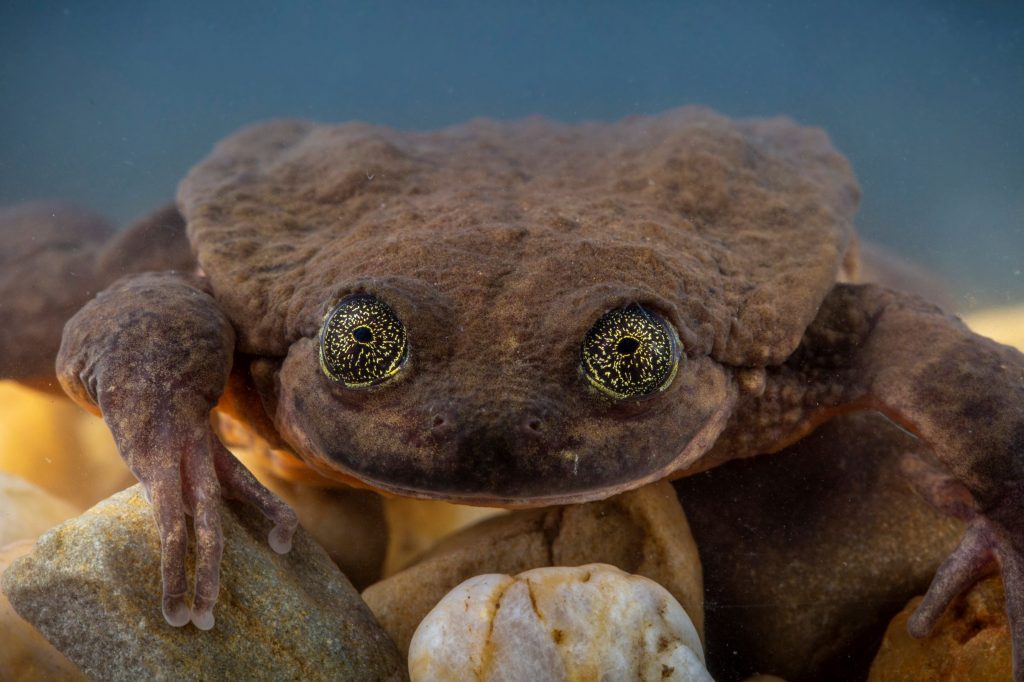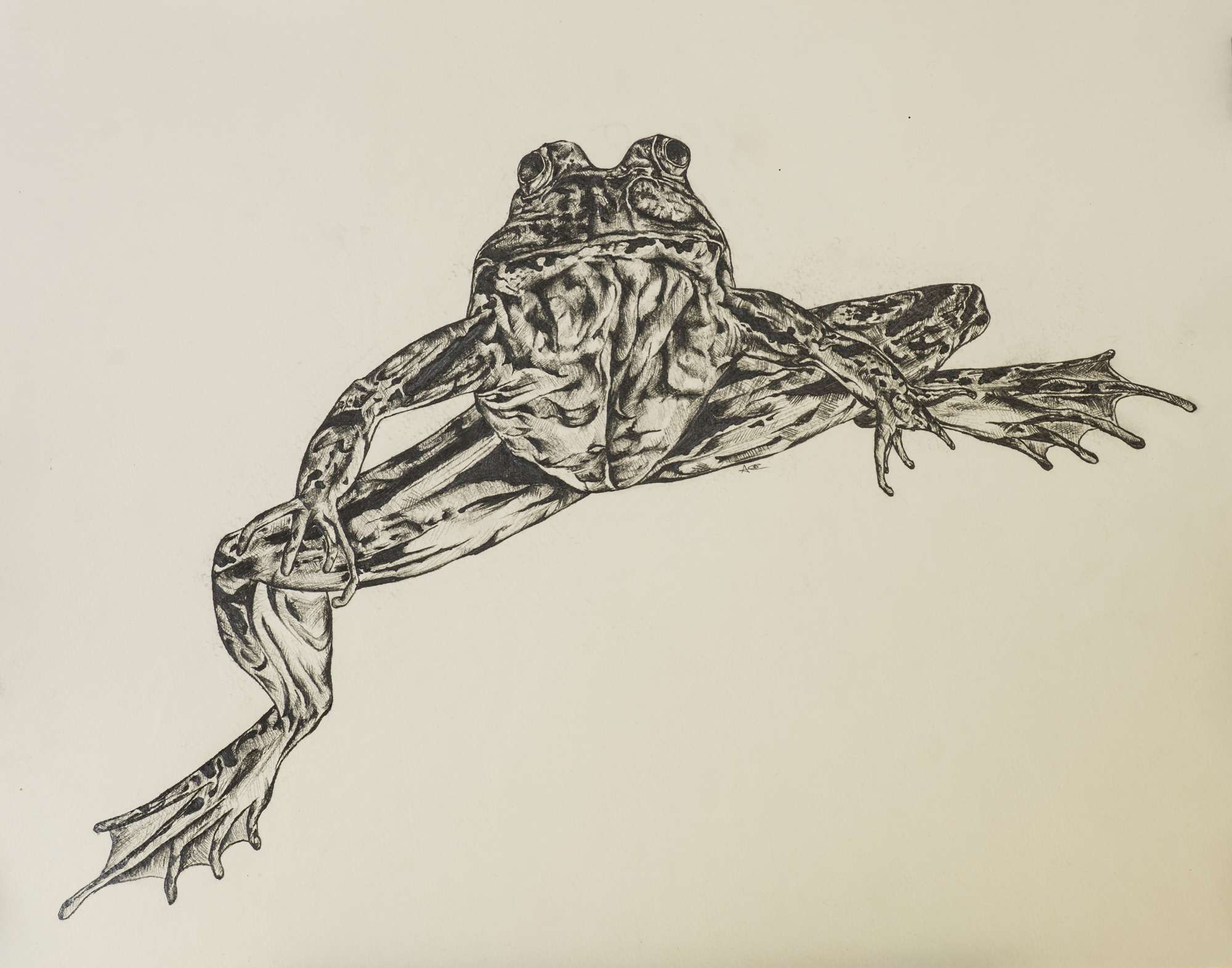I stumbled across this image in a December 20, 2023 article by Dorothy Woodend for The Tyee where she is the culture editor,
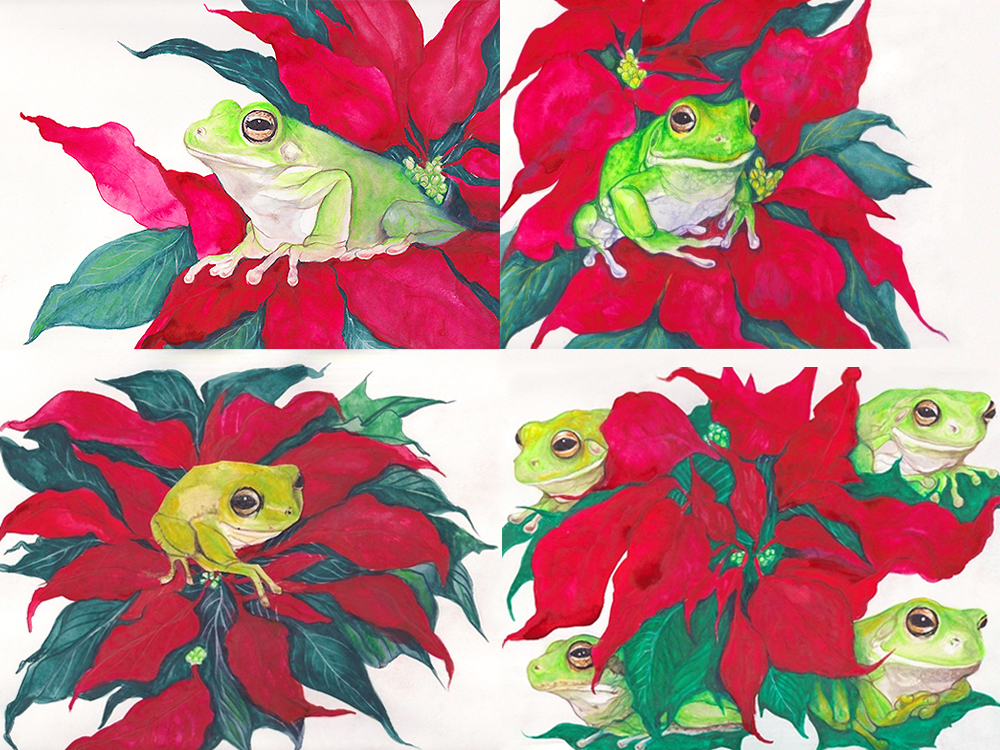
À propos given the name for this blog and the time of year. Thank you, Ms. Woodend!
I try not to do too many of these stories since the focus for this blog is new and emerging science and technology but I can’t resist including these frog stories (and one dog story). Plus, there may be some tap dancing.
A new (!) fanged frog in Indonesia
This is not the tiny Indonesian fanged frog but it does show you what a fanged frog looks like, from the December 21, 2023 “What Are Fanged Frogs?” posting on the Vajiram and Ravi IAS Study Center website,
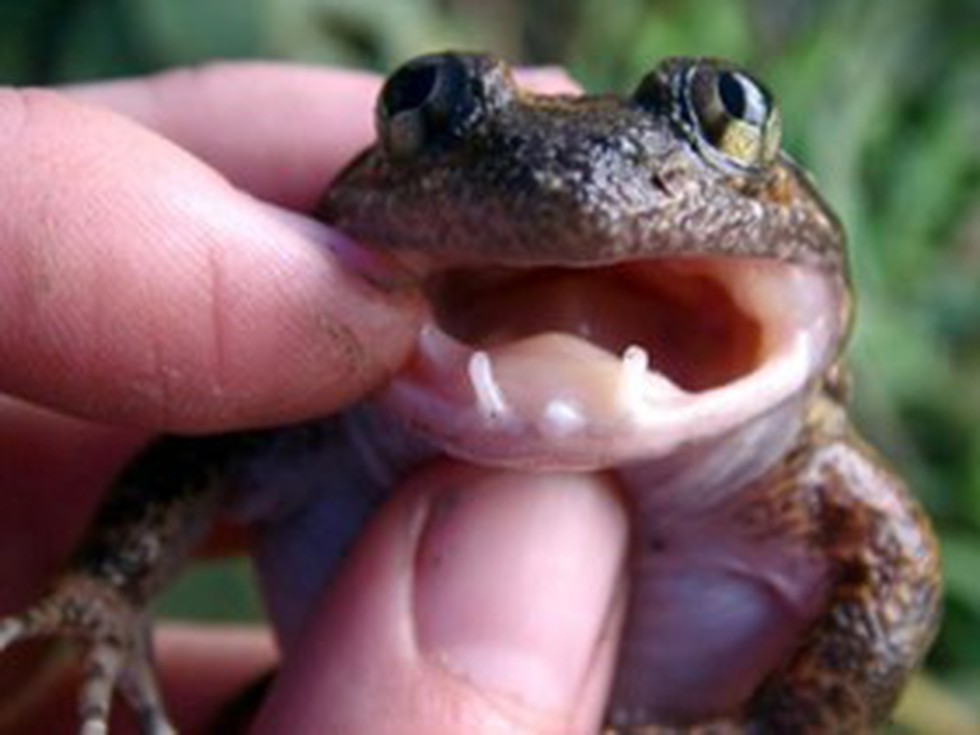
If you don’t have much time and are interested in the latest fanged frog, check out the December 21, 2023 “What Are Fanged Frogs?” posting as they have relevant information in bullet point form.
On to the specifics about the ‘new’ fanged frog from a December 21, 2023 news item on ScienceDaily,
In general, frogs’ teeth aren’t anything to write home about — they look like pointy little pinpricks lining the upper jaw. But one group of stream-dwelling frogs in Southeast Asia has a strange adaptation: two bony “fangs” jutting out of their lower jawbone. They use these fangs to battle with each other over territory and mates, and sometimes even to hunt tough-shelled prey like giant centipedes and crabs. In a new study, published in the journal PLOS [Public Library of Science] ONE, researchers have described a new species of fanged frog: the smallest one ever discovered.
“This new species is tiny compared to other fanged frogs on the island where it was found, about the size of a quarter,” says Jeff Frederick, a postdoctoral researcher at the Field Museum in Chicago and the study’s lead author, who conducted the research as a doctoral candidate at the University of California, Berkeley.
…
A December 20, 2023 Field Museum news release (also on EurrekAlert), which originated the news item, adds more detail,
“Many frogs in this genus are giant, weighing up to two pounds. At the large end, this new species weighs about the same as a dime.”
In collaboration with the Bogor Zoology Museum, a team from the McGuire Lab at Berkeley found the frogs on Sulawesi, a rugged, mountainous island that makes up part of Indonesia. “It’s a giant island with a vast network of mountains, volcanoes, lowland rainforest, and cloud forests up in the mountains. The presence of all these different habitats mean that the magnitude of biodiversity across many plants and animals we find there is unreal – rivaling places like the Amazon,” says Frederick.
While trekking through the jungle, members of the joint US-Indonesia amphibian and reptile research team noticed something unexpected on the leaves of tree saplings and moss-covered boulders: nests of frog eggs.
Frogs are amphibians, and they lay eggs that are encapsulated by jelly, rather than a hard, protective shell. To keep their eggs from drying out, most amphibians lay their eggs in water. To the research team’s surprise, they kept spotting the terrestrial egg masses on leaves and mossy boulders several feet above the ground. Shortly after, they began to see the small, brown frogs themselves.
“Normally when we’re looking for frogs, we’re scanning the margins of stream banks or wading through streams to spot them directly in the water,” Frederick says. “After repeatedly monitoring the nests though, the team started to find attending frogs sitting on leaves hugging their little nests.” This close contact with their eggs allows the frog parents to coat the eggs with compounds that keep them moist and free from bacterial and fungal contamination.
Closer examination of the amphibian parents revealed not only that they were tiny members of the fanged frog family, complete with barely-visible fangs, but that the frogs caring for the clutches of eggs were all male. “Male egg guarding behavior isn’t totally unknown across all frogs, but it’s rather uncommon,” says Frederick.
Frederick and his colleagues hypothesize that the frogs’ unusual reproductive behaviors might also relate to their smaller-than-usual fangs. Some of the frogs’ relatives have bigger fangs, which help them ward off competition for spots along the river to lay their eggs in the water. Since these frogs evolved a way to lay their eggs away from the water, they may have lost the need for such big imposing fangs. (The scientific name for the new species is Limnonectes phyllofolia; phyllofolia means “leaf-nester.”)
“It’s fascinating that on every subsequent expedition to Sulawesi, we’re still discovering new and diverse reproductive modes,” says Frederick. “Our findings also underscore the importance of conserving these very special tropical habitats. Most of the animals that live in places like Sulawesi are quite unique, and habitat destruction is an ever-looming conservation issue for preserving the hyper-diversity of species we find there. Learning about animals like these frogs that are found nowhere else on Earth helps make the case for protecting these valuable ecosystems.”
Here’s a link to and a citation for the paper,
A new species of terrestrially-nesting fanged frog (Anura: Dicroglossidae) from Sulawesi Island, Indonesia by Jeffrey H. Frederick, Djoko T. Iskanda, Awal Riyanto, Amir Hamidy, Sean B. Reilly, Alexander L. Stubbs, Luke M. Bloch, Bryan Bach, Jimmy A. McGuire. PLOS ONE 18(12): e0292598 DOI: https://doi.org/10.1371/journal.pone.0292598 Published: December 20, 2023
This paper is open access and online only.
Fatal attraction to … frog noses?
Bob Yirka in a November 28, 2023 article published on phys.org describes research into some unusual mosquito behaviour, Note: Links have been removed,
A pair of environmental and life scientists, one with the University of Newcastle, in Australia, the other the German Center for Integrative Biodiversity Research, has found that one species of mosquito native to Australia targets only the noses of frogs for feeding. In their paper published in the journal Ethology, John Gould and Jose Valdez describe their three-year study of frogs and Mimomyia elegans, a species of mosquito native to Australia
As part of their study of frogs living in a pond on Kooragang Island, the pair took a lot of photographs of the amphibians in their native environment. It was upon returning to their lab and laying out the photographs that they noticed something unique—any mosquito feeding on a frog’s blood was always atop its nose. This spot, they noted, seemed precarious, as mosquitos are part of the frog diet.

Sheena Goodyear posted a December 13, 2023 article containing an embedded Canadian Broadcasting Corporation (CBC) As It Happens radio programme audio file of an interview with researcher John Gould, Note: A link has been removed,
…
So why risk landing on the nose of something that wants to eat you, when there are so many other targets walking around full of delicious blood?
“In all of the occasions that we observed, it seems as if the frog didn’t realize that it had a mosquito on top of it…. They were actually quite happy, just sitting idly, while these mosquitoes were feeding on them,” Gould said.
“So it might be that the area between the eyes is a bit of a blind spot for the frogs.”
It’s also something of a sneak attack by the mosquitoes.
“Some of the mosquitoes first initially landed on the backs of the frogs,” Gould said. “They might avoid being eaten by the frogs by landing away from the head and then walking up to the nostrils to feed.
It’s a plausible theory, says amphibian expert Lea Randall, a Calgary Zoo and Wilder Institute ecologist who wasn’t involved in the research.
“Frogs have amazing vision, and any mosquito that approached from the front would likely end up as a tasty snack for a frog,” she said.
“Landing on the back and making your way undetected to the nostrils is a good strategy.”
And the reward may just be worth the risk.
“I could also see the nostrils as being a good place to feed as the skin is very thin and highly vascularized, and thus provides a ready source of blood for a hungry mosquito,” Randall said.
…
Gould admits his friends and loved ones have likely grown weary of hearing him “talking about frogs and nostrils.” But for him, it’s more than a highly specific scientific obsession; it’s about protecting frogs.
His earlier research has suggested that mosquitoes may be a vector for transmitting amphibian chytrid fungus, which is responsible for declines in frog populations worldwide.
That’s why he had been amassing photos of frogs and mosquitoes in the first place.
“Now that we know where the mosquito is more likely to land, it might give us a better impression about how the infection spreads along the skin of the frog,” he said.
…
But more work needs to be done. His frog nostril research, while it encompasses three years’ of fieldwork, is a natural history observation, not a laboratory study with controlled variables.
“It would be quite interesting to know whether this particular type of mosquito is transferring the chytrid fungus, and also how the fungus spreads once the mosquito has landed,” Gould said.
…

Vampire scientist, eh? You can find the embedded 6 mins. 28 secs. audio file in the December 13, 2023 article on the CBC website.
Here’s a link to and a citation for the research paper,
A little on the nose: A mosquito targets the nostrils of tree frogs for a blood meal by John Gould, Jose W. Valdez. Ethology DOI: https://doi.org/10.1111/eth.13424 First published: 21 November 2023
This paper is open access.
Gifted dogs

A December 14, 2023 news item on phys.org describes some intriguing research from Hungary,
All dog owners think that their pups are special. Science now has documented that some rare dogs are even more special. They have a talent for learning hundreds of names of dog toys. Due to the extreme rarity of this phenomenon, until recently, very little was known about these dogs, as most of the studies that documented this ability included only a small sample of one or two dogs.
A December 18,2023 Eötvös Loránd University (ELTE) press release (also on EurekAlert but published December 14, 2023), which originated the news item, delves further into the research,
In a previous study, the scientists found that only very few dogs could learn the names of object, mostly dog toys. The researchers wanted to understand this phenomenon better and, so they needed to find more dogs with this ability. But finding dogs with this rare talent was a challenge! For five years, the researchers tirelessly searched across the world for these unique Gifted Word Learner (GWL) dogs. As part of this search, in 2020, they launched a social media campaign and broadcasted their experiments with GWL dogs, in the hope of finding more GWL dogs.
“This was a citizen science project” explains Dr. Claudia Fugazza, team leader. “When a dog owner told us they thought their dog knew toy names, we gave them instructions on how to self-test their dog and asked them to send us the video of the test”. The researchers then held an online meeting with the owners to test the dog’s vocabulary under controlled conditions and, if the dog showed he knew the names of his toys, the researchers asked the owners to fill out a questionnaire. “In the questionnaire, we asked the owners about their dog’s life experience, their own experience in raising and training dogs, and about the process by which the dog came to learn the names of his/her toys” explains Dr. Andrea Sommese, co-author.
VIDEO ABSTRACT ABOUT THE RESEARCH
The researchers found 41 dogs from 9 different countries: the US, the UK, Brazil, Canada, Norway, Netherlands, Spain, Portugal and Hungary. Most of the previous studies on this topic included Border collies. So, while object label learning is very rare even in Border collies, it was not surprising that many of the dogs participating in the current study (56%) belonged to this breed. However, the study documented the ability to learn toy names in a few dogs from non-working breeds, such as two Pomeranians, one Pekingese, one Shih Tzu, a Corgi, a Poodle, and a few mixed breeds.
“Surprisingly, most owners reported that they did not intentionally teach their dogs toy names, but rather that the dogs just seemed to spontaneously pick up the toy names during unstructured play sessions,” says Shany Dror, lead researcher. In addition, the vast majority of owners participating in the study had no professional background in dog training and the researchers found no correlations between the owners’ level of experience in handling and training dogs, and the dogs’ ability to select the correct toys when hearing its names.
“In our previous studies we have shown that GWL dogs learn new object names very fast” explains Dror. “So, it is not surprising that when we conducted the test with the dogs, the average number of toys known by the dogs was 29, but when we published the results, more than 50% of the owners reported that their dogs had already acquired a vocabulary of over 100 toy names”.
“Because GWL dogs are so rare, until now there were only anecdotes about their background” explains Prof. Adam Miklósi, Head of the Ethology Department at ELTE and co-author. “The rare ability to learn object names is the first documented case of talent in a non-human species. The relatively large sample of dogs documented in this study, helps us to identify the common characteristics that are shared among these dogs, and brings us one step closer in the quest of understanding their unique ability”.
This research is part of the Genius Dog Challenge research project which aims to understand the unique talent that Gifted Word Learner dogs have. The researchers encourage dog owners who believe their dogs know multiple toy names, to contact them via the Genius Dog Challenge website.
Here’s a link to and a citation for the research paper,
A citizen science model turns anecdotes into evidence by revealing similar characteristics among Gifted Word Learner dogs by Shany Dror, Ádám Miklósi, Andrea Sommese & Claudia Fugazza. Scientific Reports volume 13, Article number: 21747 (2023) DOI: https://doi.org/10.1038/s41598-023-47864-5 Published: 14 December 2023
This paper is open access.
The End with an origin story NORAD’s Santa Tracker and some tap dancing
At the height of Cold War tensions between the US and Russia, the red phone (to be used only by the US president or a four star genera) rang at the North American Aerospace Defense Command (NORAD). Before the conversation ended, the colonel in charge had driven a child to tears and put in motion the start of a beloved Christmas tradition.
There’s a short version and a long version and if you want all the details read both,
- How a child’s accidental call to a top-secret phone line launched NORAD’s Santa Tracker (short version: December 24, 2023 story on the CBC news website)
- 3 Things you should know about how a beloved Christmas tradition got its start in the Cold War, how researchers use science to improve traditional recipes, and how the cold you feel in winter doesn’t actually exist (long version: December 14, 2023 posting by Erin Gregory, Renée-Claude Goulet, and Michelle Campbell Mekarski for Ingenium, Canada’s Museums of Science and Technology)
As for the tap dancing, I have three links:
- “Irish Dancers Face Off Against American Tap Dancers To Deliver EPIC Performance!” is an embedded 8 mins. dance off video (scroll down past a few paragraphs) in Erin Perri’s September 1, 2017 posting for themix.net. And, if you scroll further down to the bottom of Perri’s post, you’ll see an embedded video of Sammy Davis Jr.
…
In the video …, along with his dad and uncle, Sammy performs at an unbelievable pace. In the last 30 seconds of this routine, Sammy demonstrates more talent than other dancers are able to cram into a lifelong career! You can see these three were breakdancing long before it became a thing in the 1980s and they did it wearing tap shoes!
..
2. “Legendary Nicholas Brothers Dance Routine Was Unrehearsed and Filmed in One Take” embedded at the end of Emma Taggart’s October 4, 2019 posting on mymodernmet.com
3. Finally, there’s “Jill Biden releases extravagant dance video to celebrate Christmas at the White House” with a video file embedded (wait for it to finish loading and scroll down a few paragraphs) in Kate Fowler’s December 15, (?) 2023 article for MSN. It’s a little jazz, a little tap, and a little Christmas joy.
Joyeux Noël!


